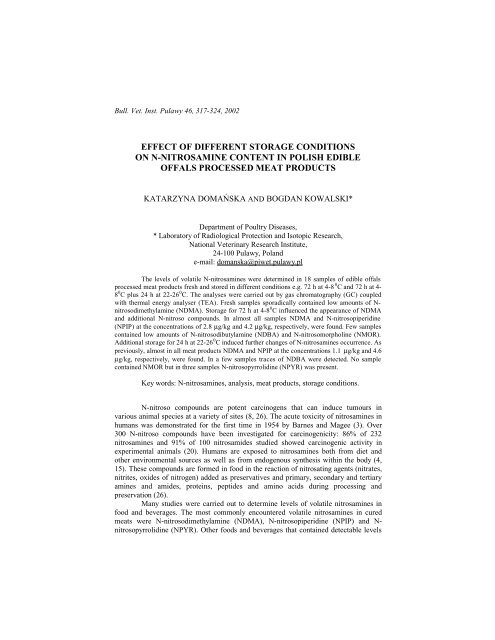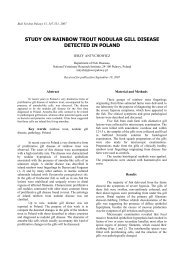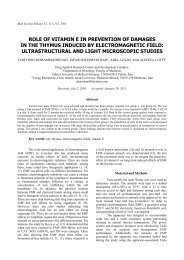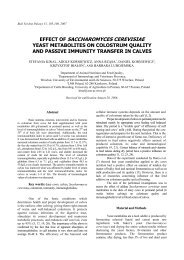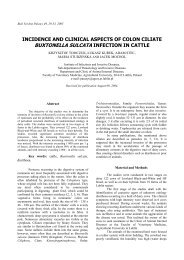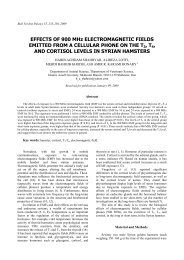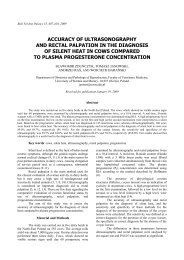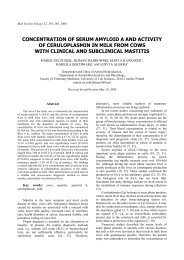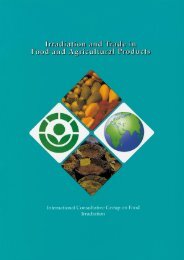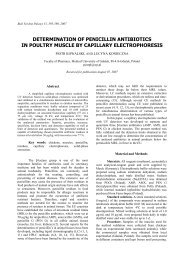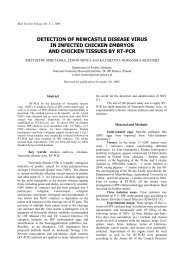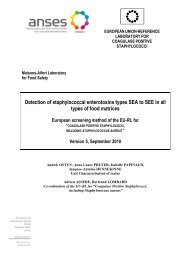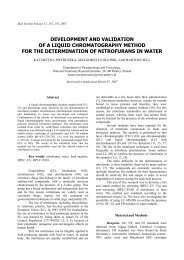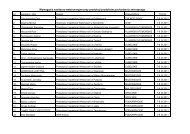effect of different storage conditions on n-nitrosamine content in ...
effect of different storage conditions on n-nitrosamine content in ...
effect of different storage conditions on n-nitrosamine content in ...
You also want an ePaper? Increase the reach of your titles
YUMPU automatically turns print PDFs into web optimized ePapers that Google loves.
Bull. Vet. Inst. Pulawy 46, 317-324, 2002EFFECT OF DIFFERENT STORAGE CONDITIONSON N-NITROSAMINE CONTENT IN POLISH EDIBLEOFFALS PROCESSED MEAT PRODUCTSKATARZYNA DOMAŃSKA AND BOGDAN KOWALSKI*Department <str<strong>on</strong>g>of</str<strong>on</strong>g> Poultry Diseases,* Laboratory <str<strong>on</strong>g>of</str<strong>on</strong>g> Radiological Protecti<strong>on</strong> and Isotopic Research,Nati<strong>on</strong>al Veter<strong>in</strong>ary Research Institute,24-100 Pulawy, Polande-mail: domanska@piwet.pulawy.plThe levels <str<strong>on</strong>g>of</str<strong>on</strong>g> volatile N-<strong>nitrosam<strong>in</strong>e</strong>s were determ<strong>in</strong>ed <strong>in</strong> 18 samples <str<strong>on</strong>g>of</str<strong>on</strong>g> edible <str<strong>on</strong>g>of</str<strong>on</strong>g>falsprocessed meat products fresh and stored <strong>in</strong> <str<strong>on</strong>g>different</str<strong>on</strong>g> <str<strong>on</strong>g>c<strong>on</strong>diti<strong>on</strong>s</str<strong>on</strong>g> e.g. 72 h at 4-8 0 C and 72 h at 4-8 0 C plus 24 h at 22-26 0 C. The analyses were carried out by gas chromatography (GC) coupledwith thermal energy analyser (TEA). Fresh samples sporadically c<strong>on</strong>ta<strong>in</strong>ed low amounts <str<strong>on</strong>g>of</str<strong>on</strong>g> N-nitrosodimethylam<strong>in</strong>e (NDMA). Storage for 72 h at 4-8 0 C <strong>in</strong>fluenced the appearance <str<strong>on</strong>g>of</str<strong>on</strong>g> NDMAand additi<strong>on</strong>al N-nitroso compounds. In almost all samples NDMA and N-nitrosopiperid<strong>in</strong>e(NPIP) at the c<strong>on</strong>centrati<strong>on</strong>s <str<strong>on</strong>g>of</str<strong>on</strong>g> 2.8 µg/kg and 4.2 µg/kg, respectively, were found. Few samplesc<strong>on</strong>ta<strong>in</strong>ed low amounts <str<strong>on</strong>g>of</str<strong>on</strong>g> N-nitrosodibutylam<strong>in</strong>e (NDBA) and N-nitrosomorphol<strong>in</strong>e (NMOR).Additi<strong>on</strong>al <str<strong>on</strong>g>storage</str<strong>on</strong>g> for 24 h at 22-26 0 C <strong>in</strong>duced further changes <str<strong>on</strong>g>of</str<strong>on</strong>g> N-<strong>nitrosam<strong>in</strong>e</strong>s occurrence. Aspreviously, almost <strong>in</strong> all meat products NDMA and NPIP at the c<strong>on</strong>centrati<strong>on</strong>s 1.1 µg/kg and 4.6µg/kg, respectively, were found. In a few samples traces <str<strong>on</strong>g>of</str<strong>on</strong>g> NDBA were detected. No samplec<strong>on</strong>ta<strong>in</strong>ed NMOR but <strong>in</strong> three samples N-nitrosopyrrolid<strong>in</strong>e (NPYR) was present.Key words: N-<strong>nitrosam<strong>in</strong>e</strong>s, analysis, meat products, <str<strong>on</strong>g>storage</str<strong>on</strong>g> <str<strong>on</strong>g>c<strong>on</strong>diti<strong>on</strong>s</str<strong>on</strong>g>.N-nitroso compounds are potent carc<strong>in</strong>ogens that can <strong>in</strong>duce tumours <strong>in</strong>various animal species at a variety <str<strong>on</strong>g>of</str<strong>on</strong>g> sites (8, 26). The acute toxicity <str<strong>on</strong>g>of</str<strong>on</strong>g> <strong>nitrosam<strong>in</strong>e</strong>s <strong>in</strong>humans was dem<strong>on</strong>strated for the first time <strong>in</strong> 1954 by Barnes and Magee (3). Over300 N-nitroso compounds have been <strong>in</strong>vestigated for carc<strong>in</strong>ogenicity: 86% <str<strong>on</strong>g>of</str<strong>on</strong>g> 232<strong>nitrosam<strong>in</strong>e</strong>s and 91% <str<strong>on</strong>g>of</str<strong>on</strong>g> 100 nitrosamides studied showed carc<strong>in</strong>ogenic activity <strong>in</strong>experimental animals (20). Humans are exposed to <strong>nitrosam<strong>in</strong>e</strong>s both from diet andother envir<strong>on</strong>mental sources as well as from endogenous synthesis with<strong>in</strong> the body (4,15). These compounds are formed <strong>in</strong> food <strong>in</strong> the reacti<strong>on</strong> <str<strong>on</strong>g>of</str<strong>on</strong>g> nitrosat<strong>in</strong>g agents (nitrates,nitrites, oxides <str<strong>on</strong>g>of</str<strong>on</strong>g> nitrogen) added as preservatives and primary, sec<strong>on</strong>dary and tertiaryam<strong>in</strong>es and amides, prote<strong>in</strong>s, peptides and am<strong>in</strong>o acids dur<strong>in</strong>g process<strong>in</strong>g andpreservati<strong>on</strong> (26).Many studies were carried out to determ<strong>in</strong>e levels <str<strong>on</strong>g>of</str<strong>on</strong>g> volatile <strong>nitrosam<strong>in</strong>e</strong>s <strong>in</strong>food and beverages. The most comm<strong>on</strong>ly encountered volatile <strong>nitrosam<strong>in</strong>e</strong>s <strong>in</strong> curedmeats were N-nitrosodimethylam<strong>in</strong>e (NDMA), N-nitrosopiperid<strong>in</strong>e (NPIP) and N-nitrosopyrrolid<strong>in</strong>e (NPYR). Other foods and beverages that c<strong>on</strong>ta<strong>in</strong>ed detectable levels
318<str<strong>on</strong>g>of</str<strong>on</strong>g> these <strong>nitrosam<strong>in</strong>e</strong>s <strong>in</strong>cluded cheese, beer and certa<strong>in</strong> milk products (10). In a surveyc<strong>on</strong>ducted <strong>in</strong> France, Biaudet et al. (5) analyzed 556 food samples. NDMA was found<strong>in</strong> 427 samples (68%) but <strong>on</strong>ly traces were noted <strong>in</strong> meat products (0.04-0.46 µg/kg)and the highest level was observed <strong>in</strong> fish (13.4 µg/kg). In a food survey c<strong>on</strong>ducted <strong>in</strong>Germany, NDMA was detected <strong>in</strong> 31.5% <str<strong>on</strong>g>of</str<strong>on</strong>g> analyzed samples. The major dietarysources <str<strong>on</strong>g>of</str<strong>on</strong>g> this compound <strong>in</strong>cluded cooked meat products (0.2-2.5 µg/kg), cooked fish(0.5-8.0 µg/kg) and spices (0.1-1.4 µg/kg). The other volatile N-<strong>nitrosam<strong>in</strong>e</strong>s, NPIPand NPYR were detected at very high c<strong>on</strong>centrati<strong>on</strong> up to 23.0 µg/kg and 29.0 µg/kg,respectively, <strong>in</strong> ground pepper (25). The m<strong>on</strong>itor<strong>in</strong>g studies undertaken to determ<strong>in</strong>ethe level <str<strong>on</strong>g>of</str<strong>on</strong>g> N-<strong>nitrosam<strong>in</strong>e</strong>s <strong>in</strong> Polish food revealed that 71% cured and 61%pasteurized pork hams c<strong>on</strong>ta<strong>in</strong>ed NDMA <strong>in</strong> the range <str<strong>on</strong>g>of</str<strong>on</strong>g> 0.1-0.5 µg/kg; also N-nitrosodiethylam<strong>in</strong>e (NDEA) (0.3-1.6 µg/kg), N-nitrosodibutylam<strong>in</strong>e (NDBA) (1.7-7.5µg/kg) and NPIP (1.4-2.2 µg/kg) occasi<strong>on</strong>ally were found (28). Kowalski et al. (13)reported NDMA <strong>in</strong> 63.3% <str<strong>on</strong>g>of</str<strong>on</strong>g> 330 analyzed processed poultry products with the meanc<strong>on</strong>centrati<strong>on</strong> <str<strong>on</strong>g>of</str<strong>on</strong>g> 1.57 µg/kg and also sporadically NDBA and N-nitrosomorphol<strong>in</strong>e(NMOR). Similar situati<strong>on</strong> was observed <strong>in</strong> the survey <str<strong>on</strong>g>of</str<strong>on</strong>g> edible <str<strong>on</strong>g>of</str<strong>on</strong>g>fals processed meatproducts: 67.6% samples c<strong>on</strong>ta<strong>in</strong>ed NDMA with the mean c<strong>on</strong>centrati<strong>on</strong> <str<strong>on</strong>g>of</str<strong>on</strong>g> 1.39 µg/kg.Analysis <str<strong>on</strong>g>of</str<strong>on</strong>g> 280 samples <str<strong>on</strong>g>of</str<strong>on</strong>g> t<strong>in</strong>ned food revealed that 46.1% c<strong>on</strong>ta<strong>in</strong>ed NDMA and/orNPIP <strong>in</strong> the range <str<strong>on</strong>g>of</str<strong>on</strong>g> 0.07-4.5 µg/kg.Due to traditi<strong>on</strong> and c<strong>on</strong>sumpti<strong>on</strong> habits, the edible <str<strong>on</strong>g>of</str<strong>on</strong>g>fals processed meatproducts (such as “kaszanka” – blood sausage, “salces<strong>on</strong>” - headcheese, “pasztetowa” –liver sausage etc. (19)) are produced and c<strong>on</strong>sumed <strong>in</strong> large amounts <strong>in</strong> Poland. Verylimited reports <strong>on</strong> the occurrence <str<strong>on</strong>g>of</str<strong>on</strong>g> N-<strong>nitrosam<strong>in</strong>e</strong>s <strong>in</strong> such k<strong>in</strong>d <str<strong>on</strong>g>of</str<strong>on</strong>g> meat products areavailable from other countries. Results <str<strong>on</strong>g>of</str<strong>on</strong>g> previous tentative studies <strong>on</strong> N-<strong>nitrosam<strong>in</strong>e</strong>soccurrence <strong>in</strong> Polish edible <str<strong>on</strong>g>of</str<strong>on</strong>g>fals processed meat products suggested that due tospecific recipes <str<strong>on</strong>g>of</str<strong>on</strong>g> producti<strong>on</strong> and very short shelf-life, <str<strong>on</strong>g>storage</str<strong>on</strong>g> <str<strong>on</strong>g>c<strong>on</strong>diti<strong>on</strong>s</str<strong>on</strong>g> <strong>in</strong>fluence theappearance <str<strong>on</strong>g>of</str<strong>on</strong>g> N-<strong>nitrosam<strong>in</strong>e</strong>s <strong>in</strong> these products. The objective <str<strong>on</strong>g>of</str<strong>on</strong>g> this work was toexam<strong>in</strong>e the <str<strong>on</strong>g>effect</str<strong>on</strong>g> <str<strong>on</strong>g>of</str<strong>on</strong>g> <str<strong>on</strong>g>different</str<strong>on</strong>g> <str<strong>on</strong>g>storage</str<strong>on</strong>g> <str<strong>on</strong>g>c<strong>on</strong>diti<strong>on</strong>s</str<strong>on</strong>g> <str<strong>on</strong>g>of</str<strong>on</strong>g> these products <strong>on</strong> the c<strong>on</strong>tent andformati<strong>on</strong> <str<strong>on</strong>g>of</str<strong>on</strong>g> volatile N-<strong>nitrosam<strong>in</strong>e</strong>s.Material and MethodsSamples. Eighteen samples <str<strong>on</strong>g>of</str<strong>on</strong>g> <str<strong>on</strong>g>different</str<strong>on</strong>g> edible <str<strong>on</strong>g>of</str<strong>on</strong>g>fals processed meat products(“salces<strong>on</strong>”, “pasztetowa”, “kaszanka”) were taken from meat factories, just afterf<strong>in</strong>ished producti<strong>on</strong> cycle, and transported <strong>in</strong> refrigerated c<strong>on</strong>ta<strong>in</strong>ers to the laboratoryfor analysis. Samples, each about 1 kg, were divided <strong>in</strong>to three groups. First <strong>on</strong>e wasthe “fresh” samples, sec<strong>on</strong>d and third were wrapped <strong>in</strong> alum<strong>in</strong>um foil and stored <strong>in</strong><str<strong>on</strong>g>different</str<strong>on</strong>g> <str<strong>on</strong>g>c<strong>on</strong>diti<strong>on</strong>s</str<strong>on</strong>g>. Sec<strong>on</strong>d group <str<strong>on</strong>g>of</str<strong>on</strong>g> samples was stored for 72 h at 4-8 0 C and thethird group was stored for 72 h at 4-8 0 C and additi<strong>on</strong>ally for 24 h at room temperature(RT). On each sampl<strong>in</strong>g date the probes were frozen at –35 0 C and later the N-<strong>nitrosam<strong>in</strong>e</strong>s levels were determ<strong>in</strong>ed.Volatile <strong>nitrosam<strong>in</strong>e</strong> analysis. Volatile <strong>nitrosam<strong>in</strong>e</strong>s were extracted by lowtemperature vacuum distillati<strong>on</strong> accord<strong>in</strong>g to method recommended by the Food Safetyand Inspecti<strong>on</strong> Service (FSIS) (7). The distillate extracts were quantitatively analyzed<strong>on</strong> a gas chromatograph (GC, Varian, model 1440) <strong>in</strong>terfaced with a thermal energyanalyzer (TEA, model 502A, Thermo Electr<strong>on</strong> Corporati<strong>on</strong>, Waltham, MA).Identificati<strong>on</strong> and quantificati<strong>on</strong> <str<strong>on</strong>g>of</str<strong>on</strong>g> the <strong>nitrosam<strong>in</strong>e</strong>s were carried out by analysis <str<strong>on</strong>g>of</str<strong>on</strong>g>
319known amounts <str<strong>on</strong>g>of</str<strong>on</strong>g> <strong>nitrosam<strong>in</strong>e</strong> standards c<strong>on</strong>ta<strong>in</strong><strong>in</strong>g N-nitrosodimethylam<strong>in</strong>e(NDMA), N-nitrosodiethylam<strong>in</strong>e (NDEA), N-nitrosodipropylam<strong>in</strong>e (NDPA), N-nitrosodibuthylam<strong>in</strong>e (NDBA), N-nitrosopiperid<strong>in</strong>e (NPIP), N-nitrosopyrrolid<strong>in</strong>e(NPYR), N-nitrosomorphol<strong>in</strong>e (NMOR) (certified standards from Chem-Services,which is also supplier <str<strong>on</strong>g>of</str<strong>on</strong>g> N-<strong>nitrosam<strong>in</strong>e</strong> standards for the Food and DrugAdm<strong>in</strong>istrati<strong>on</strong> -FDA). N-nitrosodiisopropylam<strong>in</strong>e (NDiPA) added to the samplesbefore extracti<strong>on</strong> was used as the <strong>in</strong>ternal standard. GC-TEA <str<strong>on</strong>g>c<strong>on</strong>diti<strong>on</strong>s</str<strong>on</strong>g> were asfollows: column: 2.7 m x 3 mm i.d. packed with 15% Carbowax 20 M-TPA <strong>on</strong> aChrom W-HP 80/100 mesh; column temperature: 170 0 C; <strong>in</strong>jecti<strong>on</strong> port temperature:200 0 C; carrier gas: He at 25-30ml/m<strong>in</strong>.; TEA furnace temperature: 475 0 C; vacuum: 0.3Torr, velocity <str<strong>on</strong>g>of</str<strong>on</strong>g> oxygen: 15-20 ml/m<strong>in</strong>. The method enables the identificati<strong>on</strong> andsimultaneous quantificati<strong>on</strong> <str<strong>on</strong>g>of</str<strong>on</strong>g> seven <strong>nitrosam<strong>in</strong>e</strong>s at the level above 0.04-0.2 µg/kgdepend<strong>in</strong>g <strong>on</strong> analyzed material and compound. Recoveries were at the level <str<strong>on</strong>g>of</str<strong>on</strong>g> 76-98%. Direct c<strong>on</strong>firmati<strong>on</strong> <str<strong>on</strong>g>of</str<strong>on</strong>g> analyzed compounds was performed by gaschromatography coupled with mass spectrometry (GC: model 5970B, Hewlett-Packard;MSD: Electr<strong>on</strong> Impact, EI, 70eV) accord<strong>in</strong>g to method recommended by FSIS (7).Statistical calculati<strong>on</strong>s. Results are expressed as mean ± SD <str<strong>on</strong>g>of</str<strong>on</strong>g> N-<strong>nitrosam<strong>in</strong>e</strong>s c<strong>on</strong>centrati<strong>on</strong>s (µg/kg). The Wilcox<strong>on</strong> test was used to c<strong>on</strong>duct statisticalanalysis. Differences between mean values were c<strong>on</strong>sidered significant at P-value
320A B CNDMANDMA<strong>in</strong>ternal standardNPIPA B CNDMANPIPNDBANDBANPIPA B CNDMANPIPNDMANPIPFig.1. GC-TEA chromatograms <str<strong>on</strong>g>of</str<strong>on</strong>g> three edible <str<strong>on</strong>g>of</str<strong>on</strong>g>fals processed meat productsanalyzed A – <strong>on</strong> purchase day, B – after <str<strong>on</strong>g>storage</str<strong>on</strong>g> for 72 h at 4-8 0 C, C – after <str<strong>on</strong>g>storage</str<strong>on</strong>g> for72 h at 4-8 0 C and 24 h at room temperature.
321Table 1Mean c<strong>on</strong>centrati<strong>on</strong>s (µg/kg) <str<strong>on</strong>g>of</str<strong>on</strong>g> seven volatile N-<strong>nitrosam<strong>in</strong>e</strong>s<strong>in</strong> studied meat products stored <strong>in</strong> <str<strong>on</strong>g>different</str<strong>on</strong>g> <str<strong>on</strong>g>c<strong>on</strong>diti<strong>on</strong>s</str<strong>on</strong>g> (mean <str<strong>on</strong>g>of</str<strong>on</strong>g> 18 samples)purchaseday72 hat 4-8 0 Cplus 24 hat 22-26 0 CNDMA NDEA NDPA NDBA NPIP NPYR NMOR TN0.02 - - - - - - 0.022.8 1 - - 0.5 4.2 - 0.4 7.9 11.1 1, 2 - - 0.8 4.6 1.8 - 8.3 1NDMA - N-nitrosodimethylam<strong>in</strong>e, NDEA – N-nitrosodiethylam<strong>in</strong>e, NDPA – N-nitrosodipropylam<strong>in</strong>e, NDBA – N-nitrosodibutylam<strong>in</strong>e, NPIP – N-nitrosopiperid<strong>in</strong>e,NPYR – N-nitrosopirrolid<strong>in</strong>e, NMOR – N-nitrosomorphol<strong>in</strong>e, TN – total N-<strong>nitrosam<strong>in</strong>e</strong>s1 – significantly <str<strong>on</strong>g>different</str<strong>on</strong>g> at P
322<str<strong>on</strong>g>c<strong>on</strong>diti<strong>on</strong>s</str<strong>on</strong>g>. There are several factors which may <strong>in</strong>fluence the appearance <str<strong>on</strong>g>of</str<strong>on</strong>g><strong>nitrosam<strong>in</strong>e</strong>s. Start<strong>in</strong>g materials for <strong>nitrosam<strong>in</strong>e</strong> formati<strong>on</strong> are nitrate, nitrite andprimary, sec<strong>on</strong>dary and tertiary am<strong>in</strong>es and amides, prote<strong>in</strong>s, peptides and am<strong>in</strong>o acidsor precursors <str<strong>on</strong>g>of</str<strong>on</strong>g> these, which are transformed <strong>in</strong>to <strong>nitrosam<strong>in</strong>e</strong> precursors by microbialacti<strong>on</strong> (26). It seems that all these compounds could be present <strong>in</strong> analyzed meatproducts.Nitrate and nitrite are used as preservatives <strong>in</strong> meat products. These cur<strong>in</strong>gagents develop and stabilize the colour associated with cured meats, enhance the curedflavour and act as antioxidants. Nitrite is also antimicrobial agent that <strong>in</strong>hibitsClostridium botul<strong>in</strong>um growth and tox<strong>in</strong> producti<strong>on</strong>. Am<strong>on</strong>g studied meat products<strong>on</strong>ly “salces<strong>on</strong>” c<strong>on</strong>ta<strong>in</strong>s the greatest amount <str<strong>on</strong>g>of</str<strong>on</strong>g> salted compounds, other c<strong>on</strong>ta<strong>in</strong> theirlower amounts or n<strong>on</strong>-salted materials. On the other hand, all these products c<strong>on</strong>ta<strong>in</strong><strong>in</strong>gredients <str<strong>on</strong>g>of</str<strong>on</strong>g> plant orig<strong>in</strong> (garlic, <strong>on</strong>i<strong>on</strong>, paprika, semol<strong>in</strong>a, buckwheat groats, andherb). There are many published papers that provide evidence for the presence <str<strong>on</strong>g>of</str<strong>on</strong>g>nitrate <strong>in</strong> plant foods (6, 11, 16). The other source <str<strong>on</strong>g>of</str<strong>on</strong>g> nitrate and nitrite <strong>in</strong> theseproducts could be water used dur<strong>in</strong>g their preparati<strong>on</strong>. Vegetables, gra<strong>in</strong>s and meatscan be r<strong>in</strong>sed and cooked <strong>in</strong> water. The amount <str<strong>on</strong>g>of</str<strong>on</strong>g> nitrate/nitrite available from watertaken <strong>in</strong> <str<strong>on</strong>g>different</str<strong>on</strong>g> places differs c<strong>on</strong>siderably depend<strong>in</strong>g <strong>on</strong> water source (17).Nitrosam<strong>in</strong>e formati<strong>on</strong> is also dependent <strong>on</strong> the presence <str<strong>on</strong>g>of</str<strong>on</strong>g> am<strong>in</strong>es, amides,prote<strong>in</strong>s, peptides and am<strong>in</strong>o acids. The biogenic am<strong>in</strong>es <strong>in</strong> <str<strong>on</strong>g>different</str<strong>on</strong>g> types <str<strong>on</strong>g>of</str<strong>on</strong>g> meats andmeat products were found <strong>in</strong> a great variability <str<strong>on</strong>g>of</str<strong>on</strong>g> c<strong>on</strong>centrati<strong>on</strong>s (1). They areproduced by the acti<strong>on</strong> <str<strong>on</strong>g>of</str<strong>on</strong>g> microbial decarboxylases <strong>on</strong> free am<strong>in</strong>o acids. The ma<strong>in</strong>factors affect<strong>in</strong>g formati<strong>on</strong> <str<strong>on</strong>g>of</str<strong>on</strong>g> the biogenic am<strong>in</strong>es <strong>in</strong> foods are presence <str<strong>on</strong>g>of</str<strong>on</strong>g>microorganisms and <str<strong>on</strong>g>storage</str<strong>on</strong>g> <str<strong>on</strong>g>of</str<strong>on</strong>g> foods <strong>in</strong> <str<strong>on</strong>g>c<strong>on</strong>diti<strong>on</strong>s</str<strong>on</strong>g> enabl<strong>in</strong>g their growth (23). Silla-Santos (23) reported that the c<strong>on</strong>tent <str<strong>on</strong>g>of</str<strong>on</strong>g> am<strong>in</strong>es could <strong>in</strong>crease dur<strong>in</strong>g the <str<strong>on</strong>g>storage</str<strong>on</strong>g>. It wasshown that NDMA could be formed from such am<strong>in</strong>o acid as glyc<strong>in</strong>e, NPIP from sucham<strong>in</strong>e as cadaver<strong>in</strong>e or piperid<strong>in</strong>e and NPYR from sperm<strong>in</strong>e and spermid<strong>in</strong>e also fromam<strong>in</strong>o acid prol<strong>in</strong>e (12, 14, 24, 27). Other sources <str<strong>on</strong>g>of</str<strong>on</strong>g> precursors <str<strong>on</strong>g>of</str<strong>on</strong>g> <strong>nitrosam<strong>in</strong>e</strong>s as wellas performed <strong>nitrosam<strong>in</strong>e</strong>s could be <str<strong>on</strong>g>different</str<strong>on</strong>g> additives occurr<strong>in</strong>g <strong>in</strong> food as spices,vegetables, and herbs (25).Nitrosam<strong>in</strong>es can be formed as the result <str<strong>on</strong>g>of</str<strong>on</strong>g> chemical reacti<strong>on</strong> and alsomicrobial acti<strong>on</strong>. The analyzed meat products are made <str<strong>on</strong>g>of</str<strong>on</strong>g> compounds which could bec<strong>on</strong>tam<strong>in</strong>ated with some microorganisms (gastric walls, t<strong>on</strong>gue, blood, as well asspices, herbs and cereals), c<strong>on</strong>ta<strong>in</strong> low levels <str<strong>on</strong>g>of</str<strong>on</strong>g> added preservatives (nitrate or nitrite)and are processed <strong>in</strong> rather low temperatures (brew<strong>in</strong>g at 80-85 0 C dur<strong>in</strong>g 50-130 m<strong>in</strong>,and sometimes smok<strong>in</strong>g at 30 0 C dur<strong>in</strong>g 30-40 m<strong>in</strong>). All these cause that their shelf-lifeis rather short. They could c<strong>on</strong>ta<strong>in</strong> some microbial load just <strong>on</strong> the purchase day. The<str<strong>on</strong>g>storage</str<strong>on</strong>g> <str<strong>on</strong>g>c<strong>on</strong>diti<strong>on</strong>s</str<strong>on</strong>g> applied <strong>in</strong> our experiment additi<strong>on</strong>ally <strong>in</strong>fluenced the number <str<strong>on</strong>g>of</str<strong>on</strong>g>microorganisms, especially <str<strong>on</strong>g>storage</str<strong>on</strong>g> for 24 h at rt. Ayanaba reported thatmicroorganisms could take part <strong>in</strong> N-<strong>nitrosam<strong>in</strong>e</strong>s formati<strong>on</strong> <strong>in</strong> <str<strong>on</strong>g>different</str<strong>on</strong>g> ways: bynitrates reducti<strong>on</strong> to nitrites, degradati<strong>on</strong> <str<strong>on</strong>g>of</str<strong>on</strong>g> prote<strong>in</strong>s to am<strong>in</strong>es and am<strong>in</strong>o acids,producti<strong>on</strong> <str<strong>on</strong>g>of</str<strong>on</strong>g> enzymes carry<strong>in</strong>g nitrosati<strong>on</strong> and formati<strong>on</strong> <str<strong>on</strong>g>of</str<strong>on</strong>g> pH suitable for nitrosati<strong>on</strong>(2). Some stra<strong>in</strong>s <str<strong>on</strong>g>of</str<strong>on</strong>g> Lactobacillus casei showed a biocatalytic <str<strong>on</strong>g>effect</str<strong>on</strong>g> <strong>on</strong> the formati<strong>on</strong><str<strong>on</strong>g>of</str<strong>on</strong>g> <strong>nitrosam<strong>in</strong>e</strong>s, especially the extract <str<strong>on</strong>g>of</str<strong>on</strong>g> their <strong>in</strong>tracellular enzymes (21). Other genus<str<strong>on</strong>g>of</str<strong>on</strong>g> bacteria, like coliforms, Clostridium or Pseudom<strong>on</strong>as could also synthetize<strong>nitrosam<strong>in</strong>e</strong>s (2, 9, 22).It is known that nitrosati<strong>on</strong> reacti<strong>on</strong>s can be <strong>in</strong>fluenced by <strong>in</strong>hibitors (vitam<strong>in</strong>C and E) or catalysts (metal i<strong>on</strong>s, nucleophilic ani<strong>on</strong>s as Cl - or I - , carb<strong>on</strong>yl compounds)(26). The presence <str<strong>on</strong>g>of</str<strong>on</strong>g> such substances <strong>in</strong> studied products could not be ruled out. The
323formati<strong>on</strong> <str<strong>on</strong>g>of</str<strong>on</strong>g> N-<strong>nitrosam<strong>in</strong>e</strong>s <strong>in</strong> foods is a complex process and a large diversity <str<strong>on</strong>g>of</str<strong>on</strong>g>substances could <strong>in</strong>fluence nitrosati<strong>on</strong> reacti<strong>on</strong>.The changes <str<strong>on</strong>g>of</str<strong>on</strong>g> N-<strong>nitrosam<strong>in</strong>e</strong>s c<strong>on</strong>centrati<strong>on</strong>s observed <strong>in</strong> our experimentsafter applied <str<strong>on</strong>g>different</str<strong>on</strong>g> <str<strong>on</strong>g>storage</str<strong>on</strong>g> <str<strong>on</strong>g>c<strong>on</strong>diti<strong>on</strong>s</str<strong>on</strong>g> seem to be the result <str<strong>on</strong>g>of</str<strong>on</strong>g> chemical reacti<strong>on</strong>sbetween precursors <str<strong>on</strong>g>of</str<strong>on</strong>g> <strong>nitrosam<strong>in</strong>e</strong>s present or formed <strong>in</strong> edible <str<strong>on</strong>g>of</str<strong>on</strong>g>fals processed meatproducts. However, <strong>in</strong> the case <str<strong>on</strong>g>of</str<strong>on</strong>g> <str<strong>on</strong>g>storage</str<strong>on</strong>g> at RT the changes <strong>in</strong> N-<strong>nitrosam<strong>in</strong>e</strong>s levelscould be more the result <str<strong>on</strong>g>of</str<strong>on</strong>g> microbial acti<strong>on</strong>s.Acknowledgement: Authors gratefully acknowledge A. Mazurek and H.Dudek for excellent technical assistance.References1. Ansorena D., M<strong>on</strong>tel M. C., Rokka M., Tal<strong>on</strong> R., Eerola S., Rizzo A., RaemaekersM., Demeyer D.: Analysis <str<strong>on</strong>g>of</str<strong>on</strong>g> bioobenic am<strong>in</strong>es <strong>in</strong> nothern and southern Europeansausages and role <str<strong>on</strong>g>of</str<strong>on</strong>g> flora <strong>in</strong> am<strong>in</strong>e producti<strong>on</strong>. Meat Science, 2002, 61, 141-147.2. Ayanaba A., Alexander M.: Microbial formati<strong>on</strong> <str<strong>on</strong>g>of</str<strong>on</strong>g> <strong>nitrosam<strong>in</strong>e</strong>s <strong>in</strong> vitro. App.Mirobiol., 1973, 25, 862-868.3. Barnes J.M., Magee P. N.: Toxic properties <str<strong>on</strong>g>of</str<strong>on</strong>g> dimethyl<strong>nitrosam<strong>in</strong>e</strong>. Brit. J. Ind.Med., 1954, 11, 167-174.4. Bartsch H., Spiegelhalder B.: Envir<strong>on</strong>mental exposure to N-nitroso compounds(NNOC) and precursors: an overview. Europ. J. Cancer Prev., 1996, 5, 11-17.5. Biaudet H., Mavelle T., Debry G.: Mean daily <strong>in</strong>take <str<strong>on</strong>g>of</str<strong>on</strong>g> N-nitrosodimethylam<strong>in</strong>efrom foods and beverages <strong>in</strong> France <strong>in</strong> 1987-1992. Food Chem. Toxicol., 1994,32, 417-421.6. Borawska M., Omieljaniuk N., Rostkowski J., Otlog T., Hamid F.: Value <str<strong>on</strong>g>of</str<strong>on</strong>g>nitrates and nitrites <strong>in</strong> selected vegetables and potatoes sold <strong>in</strong> the marketplace <str<strong>on</strong>g>of</str<strong>on</strong>g>Bialystok <strong>in</strong> the years 1991-1992. Roczniki PZH, 1994, 45, 89-96.7. Food Safety and Inspecti<strong>on</strong> Service. NTR2. Determ<strong>in</strong>ati<strong>on</strong> <str<strong>on</strong>g>of</str<strong>on</strong>g> Nitrosam<strong>in</strong>es by theLow Temperature Vacuum Distillati<strong>on</strong> Procedure, Chemistry LaboratoryGuidebook Residue Chemistry, USDA-FSIS, 1991.8. Forman D.: Dietary exposure to N-nitroso compounds and the risk <str<strong>on</strong>g>of</str<strong>on</strong>g> humancancer. Cancer Surv., 1987, 6, 719-738.9. Hawksworth G.M., Hill M. J.: Bacteria and N-nitrosati<strong>on</strong> <str<strong>on</strong>g>of</str<strong>on</strong>g> sec<strong>on</strong>dary am<strong>in</strong>es.Brit. J. Cancer, 1971, 25, 520-526.10. Hecht S.S.: Approaches to cancer preventi<strong>on</strong> based <strong>on</strong> an understand<strong>in</strong>g <str<strong>on</strong>g>of</str<strong>on</strong>g> N-<strong>nitrosam<strong>in</strong>e</strong> carc<strong>in</strong>ogenesis. P.S.E.B.M., 1997, 216, 181-191.11. Hunt J., Turner M. K.: A survey <str<strong>on</strong>g>of</str<strong>on</strong>g> nitrite c<strong>on</strong>centrati<strong>on</strong>s <strong>in</strong> retail fresh vegetables.Food Additives and C<strong>on</strong>tam., 1994, 11, 327-332.12. Juszkiewicz T.: Żródła nitrozoam<strong>in</strong> w żywności pochodzenia zwierzęcego.Medycyna Wet., 1978, 34, 412-417.13. Kowalski B., Domańska K., Rachubik J.: Badania lotnych N-nitrozoam<strong>in</strong> wkrajowych przetworach mięsnych. Raport z badań m<strong>on</strong>itorowych nad jakościągleb, rośl<strong>in</strong>, produktów rolniczych i spożywczych w 1998 roku. MRiRWWarszawa 1999, 142-146.14. Maga J.A.: Am<strong>in</strong>es <strong>in</strong> foods. Crit. Rev. Food Sci., 1978, 10, 373-380.15. Mirvish S.S.: Role <str<strong>on</strong>g>of</str<strong>on</strong>g> N-nitroso compounds (NOC) and N-nitrosati<strong>on</strong> <strong>in</strong> etiology<str<strong>on</strong>g>of</str<strong>on</strong>g> gastric, esophageal, nasopharyngeal and bladder cancer and c<strong>on</strong>tributi<strong>on</strong> to
324cancer <str<strong>on</strong>g>of</str<strong>on</strong>g> known exposures to NOC. Cancer Lett., 1995, 93, 17-48.16. Nabrzyski M., Gajewska R.: The c<strong>on</strong>tent <str<strong>on</strong>g>of</str<strong>on</strong>g> nitrates and nitrites <strong>in</strong> fruits,vegetables and other foodstuffs. Roczniki PZH, 1994, 45, 167-180.17. Penn<strong>in</strong>gt<strong>on</strong> J.A.T.: Dietary exposure models for nitrates and nitrites. Food C<strong>on</strong>trol,1998, 9, 385-395.18. Polska Norma., Meat products – Sausages, PN-A-82007, 1996.19. Polska Norma., Meat and meat products – Term<strong>in</strong>ology, PN-A-82023, 200020. Preussmann R., Stewart B. W.: N-nitroso carc<strong>in</strong>ogens. In: Chemical Carc<strong>in</strong>ogens.Vol. 2 ACS M<strong>on</strong>ograph 182. Ed. C.E. Searle., 1984, American Chemical Society,Wash<strong>in</strong>gt<strong>on</strong>, DC, 643-828.21. Przybyłowski P.: Studia nad rolą wybranych szczepów bakterii fermentacjimlekowej w przemianach azotanów i syntezie N-nitrozoam<strong>in</strong>. Zeszyty NaukoweART w Olsztynie, 1984, 9, 3-59.22. Przybyłowski P., Kisza J., Karłowski K., Sajko W., Urbańska J., Janicka B.:Badania występowania azotanów i produktów ich przemian w mleku i wyrobachmleczarskich. Roczniki PZH, 1987, 38, 214-218.23. Silla-Santos M.H.: Biogenic am<strong>in</strong>es: their importance <strong>in</strong> foods. Intern. J. FoodMicrobiol., 1996, 29, 213-231.24. Smith T.A.: Am<strong>in</strong>es <strong>in</strong> food. Food Chem., 1980, 6, 169-200.25. Tricker A.R., Pfundste<strong>in</strong> B., Theobald E., Preussmann R., Spiegelhalder B.: Meandaily <strong>in</strong>take <str<strong>on</strong>g>of</str<strong>on</strong>g> volatile N-<strong>nitrosam<strong>in</strong>e</strong>s from foods and beverages <strong>in</strong> WestGermany <strong>in</strong> 1989-1990. Food Chem. Toxic., 1991, 29, 729-732.26. Tricker A.R., Preussmann R.: Carc<strong>in</strong>ogenic N-<strong>nitrosam<strong>in</strong>e</strong>s <strong>in</strong> the diet: occurrence,formati<strong>on</strong>, mechanism and carc<strong>in</strong>ogenic potential. Mutat. Res., 1991, 259, 277-289.27. Warthesen J.J., Scanlan R. A., Bills D. D., Libbey L. M.: Formati<strong>on</strong> <str<strong>on</strong>g>of</str<strong>on</strong>g>heterocyclic N-<strong>nitrosam<strong>in</strong>e</strong>s from the reacti<strong>on</strong> <str<strong>on</strong>g>of</str<strong>on</strong>g> nitrite and selected primarydiam<strong>in</strong>es and am<strong>in</strong>o acids. J. Agric. Food Chem., 1975, 23, 898-902.28. Żmudzki J., Niewiadowska A., Kowalski B., Szkoda J., Semeniuk S.: Pozostałościchemiczne w szynkach wieprzowych. Medycyna Wet., 1994, 50, 623-625.


